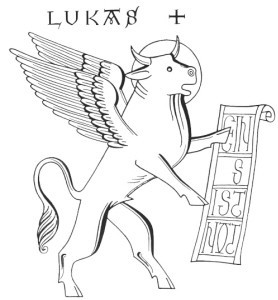The Gospel according to Luke: An Introductory Overview by Felix Just, S.J., Ph.D.
Note: Click on any underlined hyperlink below for more material on that topic.
Date of Composition: probably the mid- to late 80’s of the first centuryAttributed Author: beloved physician, a companion of Paul (Col 4:14; 2Tim 4:11; Phlm 1:24)Actual Author: 2nd generation Gentile-Christian convert, well-educated “historian”Original Readers: Christians with Gentile heritage, including some wealthier peoplePlace of Composition: Antioch in Syria? or a Greek city where St. Paul had founded a church?Literary Prologue (1:1-4): all one sentence! careful investigation, orderly account; Theophilus
A) Literary Preface & Infancy Narrative: 1:1 – 2:52 D) Jesus’ Journey to Jerusalem: 9:51 – 19:27 A') Resurrection Appearances & Ascension: 24:1-53
Luke follows Mark’s geographical structure overall:
only one year public ministry of Jesus (vs. multi-year ministry in John’s Gospel)
only one trip to Jerusalem (last week of Jesus’ life, when he is arrested and killed)
Luke keeps much of Mark’s material (making small improvements):
Luke 3:1—9:17; 9:18-50 parallels Mark 1:3—6:44; 8:27—9:40 (but omits Mark 6:45—8:26)
Luke 18:15—24:11 mostly parallels Mark 10:13—16:8
Luke rearranges some of Mark’s material (to make an “orderly account”):
Postpones call of first disciples (Mark 1:16-20) to Luke 5:1-11
Moves up Jesus’ visit to Nazareth (Mark 6:1-6a) to Luke 4:16-30
Luke adds much new material:
Prologue, Infancy Narrative, Parables, Healings, Resurrection Appearances, etc.
Luke also continues the story in a second volume: The Acts of the Apostles
Literary Features & Thematic Emphases of Luke’s Gospel
Theological Geography History
Gospel begins & ends in Temple of Jerusalem; Jesus’ journey to Jerusalem is central
Historical markers: 1:5 (days of Herod); 2:1-3 (census of Augustus); 3:1-2 (15th year of Tiberius)
Prominence of the Holy Spirit
Involved with Zechariah, Elizabeth, John the Baptist, Mary, and esp. Jesus (begin & end)
Emphasis on Prayer and Praise, Thanksgiving and Joy, Mercy and Salvation :
Hymns of praise; prayers of Jesus & other characters; Jesus’ teachings about prayer
Prominence of Parables
Focus on repentance/forgiveness wealth/possessions
Prominence of Women
Luke often pairs stories
Prominence of Food & Meals hospitality , community and sharing
“Eating your way through Luke’s Gospel”; “Breaking of the Bread” (esp. Luke 24)
Attention to the Poor & Lowly, Sick & Sinners, Women & Children, Samaritans & Gentiles
Samaritan Villagers; Parable of Good Samaritan; Healing of 10 Lepers (incl. Samaritan)
Theme of Reversal
Illustrated in Mary’s “Magnificat” (1:46-55) and many parables (Luke 10, 18, etc.)
Emphasized in Sermon on the Plain
II) Theological Highlights
Christological Titles:
Titles from Mark retained : Christ, Son of God, Son of Man, Son of David, King of JewsNew emphases in Luke’s Gospel :
Jesus is Lord (of Israel, and of all nations)
Savior (of all, but esp. the poor)God’s anointed Prophet (in word and deed)
How Jesus is portrayed in words and deeds:
More of Jesus healing the sick:
Widow of Nain (7:11-17)
Crippled Woman (13:10-17)
Man with Dropsy (14:1-6)
Ten Lepers, one a Samaritan (17:11-19)
More stories involving foreigners, esp. Samaritans:
Widow of Zarephath & Naaman the Syrian (4:25-27)
Samaritan Villagers (9:51-56)
Parable of the Good Samaritan (10:29-37)
Ten Lepers, one a Samaritan (17:11-19)
The “Inaugural Event” of Jesus’ public ministry (Luke 4:16-30; citing Isaiah 61:1-2a)
Jesus implies that he's a Prophetic Messiah (or Messianic Prophet)
Compares himself to OT prophets Elijah and Elisha
Jesus’ disciples in Luke’s Gospel, including new characters as positive role models:
Apostles: similar roles as in Matthew
Anonymous sinful woman who anoints Jesus in Galilee (Luke 7:36-50)
Galilean women: much earlier than in Matt/Mark (Luke 8:1-3)
Seventy disciples: also sent on a mission (10:1-12)
Martha and Mary of Bethany (10:38-42)
Zacchaeus, a tax collector in Jericho (19:1-10)
Explicit teachings about discipleship:
Direct Teachings:
Sermon on the Plain (6:17-49)
Would-be disciples (9:57-62)
Divisions within families (12:49-53)
Costs of discipleship (14:25-33)
Many New Parables :
Two Debtors (7:41-43)
Good Samaritan (10:25-37)
Rich Fool (12:16-21)
Lost/Prodigal Son (15:11-32)
Shrewd Steward (16:1-8)
Rich Man and Lazarus (16:19-31)
Mark: no infancy narrative; Jesus is once called “Son of Mary”; several mentions of “brothers and sisters”Matthew: focus on men, power, intrigue, violence – Joseph’s dreams – Emmanuel, Son of David, King of the JewsLUKE: focus on women, poor, joy, praise, salvation – cf. Zechariah's Benedictus , Mary’s Magnificat ; Angels' Gloria ; Simeon's Nunc Dimittis John: Jesus as the eternal Logos, the Word made flesh (“incarnation”)
The Passion Narratives of the Four Gospels (similar events, but different emphases)
Mark: suffering and rejection, scourging and derision, horribly painful death
“My God, my God, why have you abandoned me” (Mark 15:34; quoting Ps 22)
Matthew: Jewish & Roman authorities conspire against Jesus, esp. Caiaphas, Pilate, and Judas
Almost identical “last words of Jesus on the cross” in Matt 27:46 as in Mark
LUKE: innocence and forgiveness (longer dialogues at Last Supper; added trial before Herod; words of Pilate stress innocence; less abuse/mistreatment of Jesus; encounters on road to Calvary)
“Father forgive them …” (Luke 23:34)“You’ll be with me in paradise ” (23:43)“Into your hands I commend my spirit ” (23:46; …and he breathed his last; cf. Ps 31:5)
John: Jesus is in control; he “finishes” God’s work by being exalted/glorified on the cross
“I thirst” (John 19:26-27)
“Behold your son; Behold you mother” (19:28)
“It is finished” (19:30)
Mark 16 – empty tomb story only (16:1-8), no appearance story (16:9-20 added later)Matthew 28 – brief appearance to women on the road; later to disciples gathered in GalileeLUKE 24 – multiple appearances, esp. two disciples on road to Emmaus; “Ascension” story John 20–21 – appearances to Mary Magdalene, to the disciples, to Thomas; later also in Galilee
III) Related Resources by Fr. Felix: Return to the HOME PAGE of Felix Just, S.J.
This page was last updated on
November 13, 2024
Copyright © 2009; 2024
 I) Literary Considerations
I) Literary Considerations I) Literary Considerations
I) Literary Considerations![]()